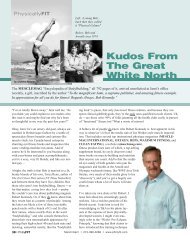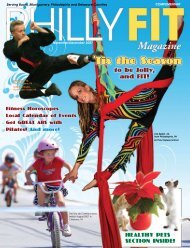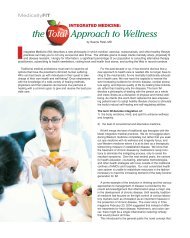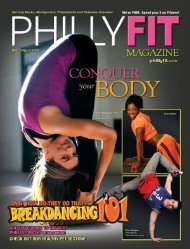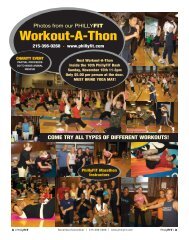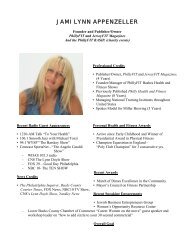Dr. Lee Cohen's PANEL OF EXPERTS!Ask <strong>the</strong> Doc!Dr. Lee CohenIn over 35 years I've helped over 25,000 men, women, and children relieve <strong>the</strong>ir pain,and I can help you too. As a Board Certified Foot and Ankle Surgeon and a Fellow of<strong>the</strong> American College of Foot and Ankle Surgeons, I have <strong>the</strong> education and experienceto provide <strong>the</strong> expert care you need. I received my Doctor of Podiatric Medicine degreefrom Temple University School of Podiatric Medicine. I served my residency atPresbyterian University Hospital and The Podiatry Hospital of Pittsburgh. I am presently<strong>the</strong> Podiatric Consultant to NFL Philadelphia Eagles Football Team, <strong>the</strong> Philadelphia76ers and <strong>the</strong> Philadelphia Wings. I am a consultant to athletic training staff at VillanovaUniversity, Princeton University, West Chester University, Temple University, DrexelUniversity, Widener University and LaSalle University. I am a member of <strong>the</strong> medical/surgicalstaff at <strong>the</strong> Crozer Keystone Health system. I have written for national magazinessuch as "Glamour," "Cosmopolitan," "Self," and "Walking".Tracy Steven Peal, Sr.Tracy Steven Peal, Sr., is an Elite Speed Coach and Movement Specialist. He has beenengaged in <strong>the</strong> field of individual and group athletics, strength training and physical conditioningfor over 15 years and continues to expand his field of expertise. As aMovement Specialist, Tracy analyzes sports biomechanics to provide <strong>the</strong> most effectiveway to increase speed, efficiency, quickness, agility, power and endurance. Through aunique re-engineering of <strong>the</strong> athlete’s understanding of movement potential and bodyperception - coupled with intense focus on specialized drills and exercises that re-trainsan athlete’s neuromuscular firing patterns in order to improve to form and technique -athletes quickly develop <strong>the</strong> skills needed to markedly improve performance and significantlydecrease injury potential.Mark MuirMark Muir has been a licensed Physical Therapist since graduating from ArcadiaUniversity in 1994 with his Master’s of Science in Physical Therapy. Mark has extensiveexperience in Physical Therapy for Orthopedic conditions, is a certified McKenzie practitionerand has been recognized as one of few health care practitioners to successfullycomplete competency training for vestibular/dizziness disorders. Mark has also beentrained in <strong>the</strong> Graston Technique. This technique utilizes specifically designed stainlesssteel instruments to detect and effectively treat areas exhibiting soft tissue fibrosis orchronic inflammation.Mandy HuggardMandy Huggard is <strong>the</strong> owner and physical <strong>the</strong>rapist at The Training Room. Mandy graduatedwith honors in 1994 from University of Florida with a Bachelor of Health Sciencedegree in Rehabilitation. She continued on to University of Miami where, in 1996, shecompleted a Master's of Science degree in Physical Therapy. While At University ofMiami she interned with <strong>the</strong> nationally ranked Hurricane Football Program assisting inathletic coverage and rehabilitation for <strong>the</strong> athletes. Upon leaving University of Miami,Mandy worked with <strong>the</strong> world renowned orthopaedic surgeon James Andrews andphysical <strong>the</strong>rapist, Kevin Wilk in Birmingham, Alabama. As both a licensed physical <strong>the</strong>rapistand athletic trainer, Mandy has treated patients from many professional organizationsincluding <strong>the</strong> NBA, NFL, NFLEL, MLB, PGA, WTA, and WWF. Mandy has lecturednationally on <strong>the</strong> topics of shoulder, knee, and elbow rehabilitation as well as, coauthoreda chapter entitled Rehabilitation Concerns of <strong>the</strong> Upper Extremity in Dr. MaryLloyd Ireland's book, The Female Athlete. Mandy specializes in <strong>the</strong> treatment of shoulderinjuries including <strong>the</strong> overhead athlete along with prevention and rehabilitation ofACL injuries and she is currently working on her Doctorate of Physical Therapy degree.Her husband, Cary is <strong>the</strong> Co-Owner of Velocity Sports Performance.Dr. MaenpaaHe's board certified, specializing in Internal Medicine. He has 16 years experience. Theaverage for this specialty is 17 years. Highly regarded by his patients <strong>the</strong>y rate him 3.5out of 4 stars. They point out easy to set appointment. He has won a number of awards,including Top Ten Doctors 2012 and Patients' Choice Award 2008. Is affiliated with <strong>the</strong>setop rated hospitals. Graduated from Univ Sheffield Medical School. His average waitingtime is 7 minutes. He has a number of insurance plans accepted. Use Vitals.com toexamine Doctor Garath A Maenpaa from Philadelphia, Pennsylvania. See patient commentsmake an appointment or even let us help you to prepare for your visit. Vitals .comwhere doctors are examined.Dr. Tricia BeattyDr. Tricia Beatty is a board certified non-surgical sports medicine physician who specializesin pediatric, adolescent, adult and female musculoskeletal injuries. She has a specialinterest in stress fracture management, overuse injuries, and injury prevention. Shehas served as a team physician on <strong>the</strong> high school, collegiate, and professional level.Dr. Beatty was highlighted as a top doc 2011 in South Jersey magazine, and this yearas <strong>the</strong> top female sports medicine physician 2012 in SJ magazine. Dr. Beatty is an athleteherself. She is a former gymnast and NCAA Division I diver, and now enjoys running,cycling, weight training and yoga. Dr. Beatty is committed to helping her patientsreturn to, and maintain an active lifestyle after acute and/or chronic injury. She practicesat The Rothman Institute – Lankenau, 100 Lancaster Ave. Medical Office Building, Suite456 East, Wynnewood, PA 19096 and The Rothman Institute – Newtown Square, 3855West Chester Pike, Suite 340, Newtown Square, PA 19073.Feel free to email us your question, we'll have <strong>the</strong>appropriate expertrespond within 48 hours… FREE!Email leescohen@aol.com now to get in touch!24 I <strong>PhillyFIT</strong>May/June I 267-767-4205 I www.phillyfit.comCutting Corners, Incorporating Exercise IntoYour Every Day LifeBy Jason RaffenspergerI have lived in <strong>the</strong> suburbs of Philadelphia all my life and have struggled mostof it with "bad habits" like smoking, anorexia, binge eating and obesity. As achild I would over eat constantly. I would pour extra sugar on my cereal andeven add Sweet’N Low ® to my diet soda. I really enjoyed <strong>the</strong> snack stand atmy little league games since I could get cheese fries with a side of SwedishFish ® . As a child, <strong>the</strong> only thing that helped keep my weight at a moderatelevel was my Karate lessons. At that age, I enjoyed everything I ate and neverworried about what I looked like or how I felt until I started noticing girls.Once that happened, my appearance was everything. I had to have <strong>the</strong> bestclo<strong>the</strong>s, newest shoes and lots of gel for my hair.As a teen, I started lifting weights with a local body builder. I learned a lotabout weight lifting, but never changed my eating habits. I soon realized cardiowas <strong>the</strong> way to go, so I started running. Being overweight, it took me a fewmonths before I could run continuously without stopping for a break. Once mybody was conditioned to running, I was able to run ten miles every day,regardless of <strong>the</strong> wea<strong>the</strong>r. The only problem with all <strong>the</strong> running was I pickedup two more "bad habits": smoking and anorexia. Looking back now, I see itvery clearly and know it all went hand and hand.However, I was blessed to meet my wife a few years later and was able toovercome anorexia with healthy eating habits. She taught me to love foodagain and it is not only ok to eat, but to eat on a regular schedule. She taughtme how to cook, or more accurately, she taught me how to read directions andfeel more comfortable preparing food. Eating is a big part of our lives and mywife taught me to embrace it and not feel guilty about eating. Around <strong>the</strong> sametime that I met my wife, my knees were starting to suffer from all of <strong>the</strong> running.I met with multiple doctors and trainers for physical <strong>the</strong>rapy. It helpedmy knees, but I am unable to run like I used to and gained back all my weightI had lost, plus some.When that happened, I started using <strong>the</strong> small gym that my office offered andwould go every day on lunch, only missing one or two days a month. I neverlost weight, but was able to maintain my weight and feel healthier.A few years later I was blessed with <strong>the</strong> news that my wife and I would behaving a daughter. A month before she was born, I decided that I smoked mylast cigarette. I went cold turkey and <strong>the</strong> first month was tough, but once I heldmy little girl I knew I would never smoke again.A few months after she was born I lost my job and <strong>the</strong> gym my office offered.I had to find a new way to exercise. After getting a new job, I didn't reallyhave <strong>the</strong> money or <strong>the</strong> time to join a gym, but knew I wanted to be in bettershape to live a longer and healthier life for my girls. I started with what I knewmost, Karate and basic stretching, eventually combining <strong>the</strong>m into my ownunique stretching routine. Next, I added my weight lifting and physical <strong>the</strong>rapyexperiences to create <strong>the</strong> rest of my exercises. In a single day I do a minimumof three thousand repetitions. Most days I spread <strong>the</strong>m out evenly to not losetime from work, home and most importantly family. However, <strong>the</strong>re are timeswhere I may have an hour to kill and can challenge myself to complete asmany repetitions as I can. These daily exercises have become my “healthyhabits.” I eat well and exercise and have not missed a day in three years.My daughter continues to inspire me every day to form more "healthy habits”.She inspired me to write down my exercise program and also have it publishedas an e-Book. My e-book is called: Cutting Corners, Incorporating Exerciseinto Your Every Day Life. The idea of my program is about creating a healthyhabit and using it on a daily basis to live a happier and healthier life.Jason Raffensperger is a fa<strong>the</strong>r and husband who uses his life experiencesfrom being an overweight youth to an anorexic young man in "CuttingCorners". Now a healthy and fit adult, Jason shares his secrets in CuttingCorners to help you balance a healthy lifestyle and a family. He createdmany of <strong>the</strong> innovative and unique exercises from a loose blend of his martialarts, weight training, and physical <strong>the</strong>rapy.
PhysicallyFIT<strong>Running</strong> <strong>the</strong><strong>Right</strong> <strong>Way</strong>By Joe Giandonato, MS, CSCSAvid gym goers and recreational athletes regularly engage incardiovascular exercise, typically comprised of running - ei<strong>the</strong>ron <strong>the</strong> treadmill or outdoors - to improve <strong>the</strong>ir body compositionand to keep in shape for <strong>the</strong>ir respective sport.Traditionally, steady state cardiovascular exercise, such as runningat <strong>the</strong> same pace for a given period of time, has been foreveradvocated by fitness professionals and sport coaches alikeas it offers a cadre of health and performance benefits, such asreducing body fat, augmenting insulin sensitivity, balancingphospholipids, and streamlining cardiac output at rest and duringbouts of exertion.Having a robust aerobic energy system, or what some refer to asan “aerobic base”, helps athletes perform better and enhances<strong>the</strong>ir recovery between workouts and repeated bouts of exertion.Individuals who engage in resistance training activities or whoplay team sports such as basketball, soccer, hockey, lacrosse, orfootball, perform <strong>the</strong> majority of <strong>the</strong>ir physiological work viaintervals. Throughout <strong>the</strong>se bouts of work, alactic, lactic, andaerobic energy systems, are working in concert to provide <strong>the</strong>body its energy currency.ATP to sustain activity. Each energy system’s contribution ofATP is contingent on <strong>the</strong> intensity and duration of <strong>the</strong> givenbout of exertion. People who are fit produce and utilize ATPmore efficiently. Additionally, <strong>the</strong>y are able to bounce backquicker between bouts of exertion and will perform better whensuccessive repeated bouts start drawing on <strong>the</strong> aerobic energysystem for ATP production.However, <strong>the</strong> majority of gym goers and recreational athletesoveremphasize steady state cardiovascular exercise, namely distancerunning, in <strong>the</strong>ir training programs. As fatigue sets in, runninggait begins to deteriorate and as <strong>the</strong> mileage piles up,injuries begin to accumulate. Most people are faultily lockedinto <strong>the</strong> mindset, that in order to peel <strong>the</strong> fat away or to gainmore endurance, <strong>the</strong>y have to add distance or time.Provided below are helpful suggestions to help you look andperform better, while warding off injury.1. Don’t progress too rapidly. Adaptations to exercise are optimizedwhen systematic progressive overload is tactfullyemployed. If you’re tackling three miles comfortably, don’tjump to six or seven just because you may be feeling good oneday. Advancing hastily in <strong>the</strong> duration and intensity of yourruns, may leave you more susceptible to injury and possiblyimpede future progress. Instead, jumps should be gradual andincremental.2. Streng<strong>the</strong>n and leng<strong>the</strong>n. Novices who partake in distancerunning beat up <strong>the</strong>ir legs and hips by heel striking too forcefullyas <strong>the</strong> swing phase ends. After <strong>the</strong> heel makes contact with<strong>the</strong> ground, <strong>the</strong> muscles, which dorsiflex <strong>the</strong> ankle act eccentricallyto lower <strong>the</strong> ball of <strong>the</strong> foot onto <strong>the</strong> ground to initiate toeoff,which commences <strong>the</strong> swing phase. In novices, who quicklyramp up <strong>the</strong>ir mileage, <strong>the</strong> muscles of <strong>the</strong> hips, posterior chain,and lower leg, haven’t grown accustomed to forces imposed on<strong>the</strong>m, triggering repetitive strain injuries and joint pain. Novicesand runners returning from a long layoff should start off byinvesting time in <strong>the</strong> gym, focusing on movements such assquats and deadlifts, performed bilaterally and unilaterally, aswell as exercises to streng<strong>the</strong>n <strong>the</strong> anterior core, gluteals, andhamstrings.Ra<strong>the</strong>r than tackle a mile or two off <strong>the</strong> bat, a series of shorterruns, around one hundred to two hundred meters, conducted ateighty percent of top end speed, should be conducted to spare<strong>the</strong> heels of <strong>the</strong> harsh repeated landing forces imposed on <strong>the</strong>mduring longer runs. This will also help improve one’s stridelength and streng<strong>the</strong>n <strong>the</strong> hip flexors, hamstrings, and gluteal,which are highly involved during maximal effort sprinting.3. Sprint your way to fat loss and better performance. Duringsprints, hundreds of muscles are rapidly firing, incurring anMay/June I 267-767-4205 I www.phillyfit.com<strong>PhillyFIT</strong> I 25



